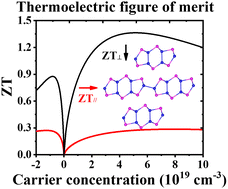Anisotropic ductility and thermoelectricity of van der Waals GeAs†
Abstract
Wearable thermoelectric applications require materials with both high energy conversion efficiency and excellent flexibility/deformability. Inorganic thermoelectric materials have shown high conversion efficiency, but they are usually brittle and have poor mechanical flexibility, which makes their integration into flexible devices a challenging task. GeAs is a group IV–V binary compound with a van der Waals layered structure, and its thermoelectric response has been reported. Herein, we investigate the mechanical and thermoelectric properties of GeAs crystal by a combination of density functional theory and density functional perturbation theory methods. Our results show that GeAs features a moderately dispersive valence band and multivalley convergence, which give rise to a large Seebeck coefficient and power factor when it is properly p-doped. Remarkably, its electrical transport in the out-of-plane direction even outperforms that in the in-plane direction, while phonon transport is suppressed, leading to a predominant thermoelectric response in the vertical direction. More interestingly, GeAs demonstrates a structural stiffness higher than thermoelectric CuInTe2 and PbTe, and a ductility ratio comparable to a recently discovered plastic semiconductor, InSe. The stress–strain curve simulation reveals that GeAs can withstand deformations up to 20%. These findings showcase GeAs as a ductile thermoelectric material suitable for wearable devices and energy conversion.



 Please wait while we load your content...
Please wait while we load your content...